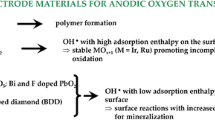Abstract
Studies of organic compounds oxidation at constant current conditions with different anodes, indicate that the oxidative action of these anodes is related to their absorption characteristic i.e. the low or high difficulty of the generated hydroxyl radicals in reaching the solution. This paper shows that the adsorption does not concern the anodic surface, but an adjacent thin layer (adsorption layer) of the aqueous solution. An estimation of the fraction of hydroxyl radicals that move from the adsorption layer to the adjacent reactive/diffusive layer is obtained as well as a suitable tool for comparison the result of this approach with the experimental results. This comparison shows how the adsorption layer modulates the runway of the organic species oxidation.





Similar content being viewed by others
References
Iniesta J, Michaud PA, Panizza M, Cerisola G, Aldaz A, Comninellis Ch (2001) Electrochemical oxidation of phenol at boron-doped diamond electrode. Electrochim Acta 46:3573
Kapalka A, Fóti G, Comninellis Ch (2010) In: Comninellis Ch, Chen G (eds) Electrochemistry for the environment. Springer, New York
Gibbs JW (1928) Collected works, vol 1. Longmans and London, New York
Israelachvili JN (1992) Intermolecular and surface forces. Academic Press, London
Miret-Artés S, Pollak E (2005) Thermodynamics of activated surface diffusion. J Phys 17:S4133
Kapalka A, Fóti G, Comninellis Ch (2009) The importance of electrode material in environmental electrochemistry: formation and reactivity of free hydroxyl radicals on boron-doped diamond electrodes. Electrochim Acta 54:2018
Enache TA, Chiorcea-Paquim AM, Fatibello-Filho O, Oliveira-Brett AM (2009) Hydroxyl radicals electrochemically generated in situ on a boron-doped diamond electrode. Electrochem Commun 11:1342
Gherardini L, Michaud PA, Panizza M, Comninellis Ch, Vatistas N (2001) Electrochemical oxidation of 4-chlorophenol for wastewater treatment. Definition of normalized current efficiency. J Electrochem Soc 148:D78
Flox C, Arias C, Brillas E, Savall A, Groenen-Serrano K (2009) Electrochemical incineration of cresols: a comparative study between PbO2 and boron-doped diamond anodes. Chemosphere 74:1340
Author information
Authors and Affiliations
Corresponding author
Additional information
Paper dedicated to Professor Christos Comninellis’ 65th birthday
Appendix
Appendix
The differential equations is of second order:
While the boundary conditions of this equation are:
The following new variable ϕ = ϕ[y(ξ)], is introduced:
This new variable is elaborated in the following way:
Using the obtained relationship in the second order differential equation it is reduced to a first order equation that is separable:
The integral of this equation is estimated by assuming as initial values a generic value of y at which correspond a generic value of ϕ, while as final values are zero for both variables. In fact when ξ→∞ both variables assumes as value zero:
And from the solution of this integral the following equation is obtained:
The new variable ϕ is substituted by dy/dξ:
And the following integral equation is obtained by considering the initial point (0, 1) and a generic point (ξ, y):
The solution of this integral is:
And the obtained equation relates the dimensionless concentration y, to dimensionless distance ξ:
The obtained concentration versus dimensionless distance must be constantly decreasing with the dimensionless distance and then the sign plus can be accepted.
At the end of adsorption layer ξ = δ a /λ a , this dimensionless concentration assumes the following value:
The derivative of this concentration that is proportional to the hydroxyl radical flow is given by the following relationship:
The ratio of hydroxyl radical flow that reaches the diffusion layer respect to the produced radicals is indicated as efficiency of the considered anode to produce free hydroxyl radicals layer and its value is given by the following relationship:
Rights and permissions
About this article
Cite this article
Vatistas, N. Adsorption layer and its characteristic to modulate the electro-oxidation runway of organic species. J Appl Electrochem 40, 1743–1750 (2010). https://doi.org/10.1007/s10800-010-0134-6
Received:
Accepted:
Published:
Issue Date:
DOI: https://doi.org/10.1007/s10800-010-0134-6




